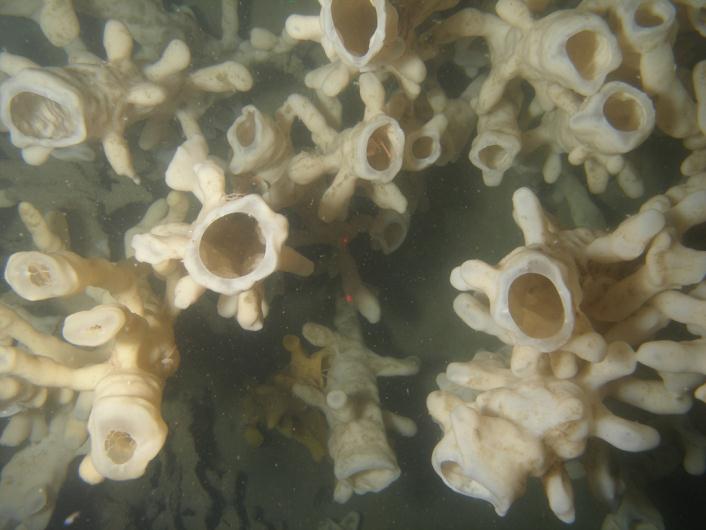Frequently asked questions
Glass Sponge Reef Marine Refuges in the Strait of Georgia and Howe Sound
1. What are glass sponges?
Answer:
Glass sponges are remarkable filter-feeding marine animals with skeletons of nearly pure glass that live in deep water.
2. What are reef-building glass sponges?
Answer:
Three species of glass sponges are reef-building, which means that they have rigid glass skeletons that remain in place after the individual sponges die. New generations of glass sponges settle on these skeletons and create mounds or reefs that can be up to 19 m high and over a kilometre wide.
3. How old is that sponge?
Answer:
Glass sponges are exceptionally long lived, and some species live for over 220 years. Radiocarbon dating suggests that the glass sponge reefs in Queen Charlotte Sound started forming 9000 years ago.
4. Where in the world can you find glass sponge reefs?
Answer:
Glass sponge reefs were common 200 million years ago. Today, you can only find them in a few locations off the Pacific coast of Canada and the United States.
5. Where in BC can you find glass sponge reefs?
Answer:
Several large glass sponge reefs have been found in Hecate Strait and Queen Charlotte Sound, and a number of smaller reef complexes have been found in the Strait of Georgia and Howe Sound. Glass sponge reefs in the southern British Columbia are generally found at depths of 90 to 300 metres, with the exception of several in Howe Sound that are as shallow as 22 metres.
6. What kind of reef-building glass sponges are found in the Strait of Georgia and Howe Sound?
Answer:
Two species of reef-forming glass sponges can be found in reefs in the Strait of Georgia and Howe Sound – the cloud sponge (Aphrocallistes vastus) and the vase sponge (Heterochone calyx).
7. How do glass sponge reefs fit into the marine ecosystem in the Strait of Georgia and Howe Sound?
Answer:
Glass sponge reefs provide habitat and refuge for many invertebrates and fish, including young rockfish. They are important for water quality because of the vast amount of water they filter, >800 times their body volume each hour. The reefs play an important role in carbon and nitrogen processing and concentrate large amounts of biological silicon which is crucial for ocean productivity.
8. Why be concerned about the conservation of glass sponge reefs in the Strait of Georgia and Howe Sound?
Answer:
Glass sponges are fragile and slow-growing. Pieces of the sponges easily break off when fishing gear or other objects hit the reef. Sediment that is stirred up near the reef can also affect sponge filter-feeding and growth. Because glass sponges grow slowly (at an estimated rate of 1-2 cm per year), glass sponge reefs in the Strait of Georgia and Howe Sound are particularly vulnerable to the direct and indirect impacts of activities such as bottom-contact fishing activities and anchorage.
9. What was the process for establishing glass sponge reef marine refuges?
Answer:
The process involved several steps, beginning with our scientists who conducted a remote operated vehicle (ROV) survey to verify where the reefs are and confirm their ecological status (condition of the reef, live or dead sponge cover, presence and diversity of species). Next, an ecological risk assessment was conducted, which looked at fishing activities in the area that can damage the reefs. Once the fishing risks were identified, an analysis was done to understand the potential social and economic impacts of closing the reefs to those types of fishing. The information was then reviewed in consultations with First Nations, BC, and local governments, industry and environmental non-profit organizations, and other interested stakeholders. Finally, marine refuges were designated to mitigate the risks of fishing to the reefs, taking into consideration what was learned throughout the establishment process.
10. What are marine refuges?
Answer:
Marine refuges are fisheries area closures that qualify as “other effective area-based conservation measures” and offer targeted protection to species and their habitat from the impacts of fishing. Marine refuges are outlined as a protection tool in the Government of Canada’s new approach to marine conservation, that includes protection standards to strengthen the conservation of our oceans.

- Date modified: